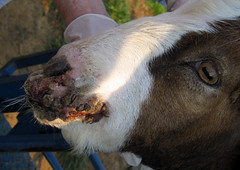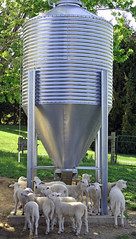 All of the infected animals developed and showed classical orf lesions at the site of infection (udder). The controls did not. Disease progression was similar to when orf infection occurs on other parts of the body. The mean incubation period was 4 days. The erythema, papule, and pustule stage took 9 to 10 days and the scabs developed and remained intact for 13 to 17 days.
All of the infected animals developed and showed classical orf lesions at the site of infection (udder). The controls did not. Disease progression was similar to when orf infection occurs on other parts of the body. The mean incubation period was 4 days. The erythema, papule, and pustule stage took 9 to 10 days and the scabs developed and remained intact for 13 to 17 days.Gross lesions were similar in severity between sheep and goats. Antibody response to the infection was also similar. Mastitis-causing bacteria were isolated from milk samples of all the infected sheep and goats, but not from the controls. The mean course of the disease ranged between 25 to 33 days and averaged 29.2 days.
Researchers concluded that udder orf lesions have a direct contribution to increasing the rate of clinical and sub-clinical mastitis among infected ewes and goats; orf disease poses a serious problem to lambs and kids, preventing them from suckling and thus causing starvation; and mastitic orf lesions can become complicated, leading to amputation of the udder in severe cases or death of the affected animals.
Source: Veterinarski arhiV 78 (3), 217-225, 2008

 The pageant offered an opportunity for breeders to do business and a rare outlet for entertainment. The goal of the competition was to encourage Saudis to breed for quality. Some of those who attended the event said Saudi sheep -- known as Nejdi sheep -- have markedly improved over the past decade because of the attention given to breeding them.
The pageant offered an opportunity for breeders to do business and a rare outlet for entertainment. The goal of the competition was to encourage Saudis to breed for quality. Some of those who attended the event said Saudi sheep -- known as Nejdi sheep -- have markedly improved over the past decade because of the attention given to breeding them.



